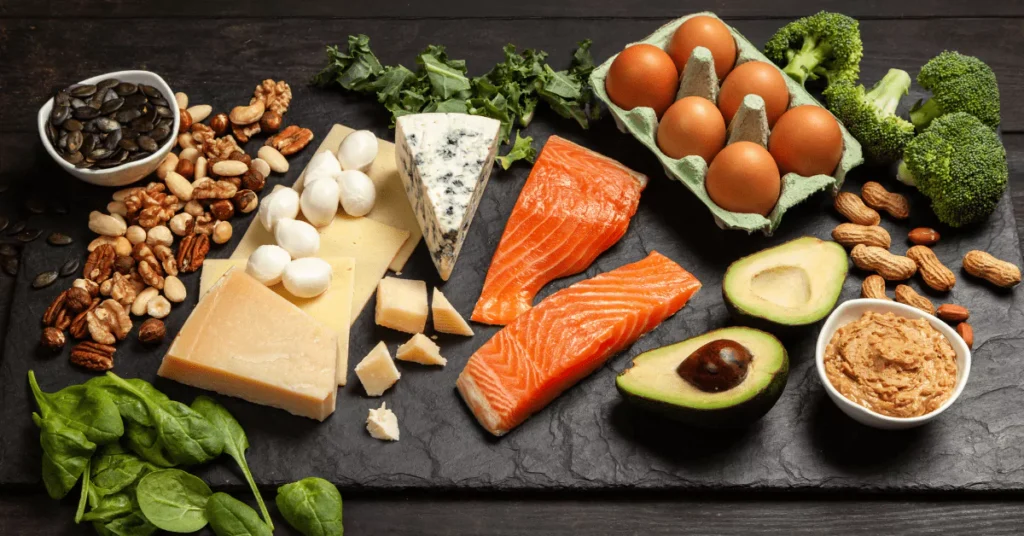Read Time: 5 minutes
How Much Fat Should I Eat Per Day?

The ideal daily fat intake varies depending on factors like age, sex, and activity level.
The Acceptable Macronutrient Distribution Range (AMDR) recommends getting 20-35% of your daily caloric intake from fats.
For example, if you consume 2,000 calories per day, approximately 400-700 of those calories should come from fats.
It’s vital to understand that not all fats are created equal, and being aware of the different types of fats can help you make healthier (and more delicious) choices.
Why Is Fat Important for Your Health?
Fat is a vital macronutrient that plays a significant role in overall health. Some of its primary functions include:
Energy Production
Fat is a dense source of energy, providing 9 calories per gram. It serves as a primary fuel source for low-intensity and long-duration activities.
Cell Function and Development
Fats, including saturated fats, are essential for the structure and function of cell membranes.
They also play a crucial role in hormone production and regulation.
Vitamin Absorption
The fat-soluble vitamins A, D, E, and K require fat for proper absorption and utilization within the body.
Appetite Regulation
Including healthy fats in your diet can help you feel fuller for longer, preventing overeating and aiding in weight management in the long term.
Types of Fats: The Good, The Ugly, and The In-Between
Differentiating between healthy and unhealthy fats is crucial when considering your daily fat intake. Here’s a quick overview:
Unsaturated Fats (The Good)
Unsaturated fats, found in plant-based foods and some fish, are considered healthy fats. They can help lower bad cholesterol levels (LDL), reduce inflammation, and support heart health. Unsaturated fats are further divided into:
1. Monounsaturated fats: found in olive oil, avocado, and nuts
2. Polyunsaturated fats: found in sunflower oil, corn oil, and fatty fish such as salmon
Trans Fats (The Bad)
Trans fats are artificially created by adding hydrogen to liquid vegetable oils, forming a more solid fat.
They are often found in processed and packaged foods. Trans fats can raise bad cholesterol levels while lowering good cholesterol (HDL) levels, significantly increasing the risk of heart disease.
It’s best to avoid or minimize trans fat consumption.
Saturated Fats (The In-Between)
Saturated fats, mainly found in animal-based foods like meat and dairy products, are necessary for hormone production and cell membrane function.
However, excessive saturated fat intake can raise bad cholesterol levels and increase the risk of heart disease.
It’s recommended to limit saturated fat intake to less than 10% of your daily calories, but it’s essential to include some saturated fat in your diet.
Fat Intake for Weight Loss and Muscle Building
Optimizing your fat intake can significantly impact weight loss and muscle building:
Weight Loss
Including healthy fats in your diet can help you feel fuller for longer and aid in weight management.
Prioritize unsaturated fats and monitor your overall caloric intake to create a calorie deficit, which is essential for weight loss.
Muscle Building
While protein is the most critical macronutrient for muscle building, fats also play a vital role in hormone production and overall energy levels.
Balancing fat intake with protein and carbohydrates can support muscle growth and recovery.
How to Determine Your Ideal Daily Fat Intake
To calculate your ideal daily fat intake, follow these steps:
1. Determine your daily caloric needs: Calculate your total daily energy expenditure (TDEE) based on factors such as age, sex, weight, height, and activity level. There are various online calculators available to assist you in this process.
2. Calculate your fat intake range: Multiply your TDEE by 0.20 and 0.35 to get your fat intake range. This will represent 20-35% of your daily caloric intake from fats.
3. Divide by 9: Since fat provides 9 calories per gram, divide the fat intake range (in calories) by 9 to get the number of grams of fat you should consume daily.
4. Distribute your fat intake wisely: Prioritize unsaturated fats (both monounsaturated and polyunsaturated) in your diet. Include some saturated fats for hormone production and cell membrane function, and avoid trans fats whenever possible.
Practical Tips for Including Healthy Fats in Your Diet
To optimize your daily fat intake, consider the following tips:
Choose Healthier Cooking Oils
Opt for oils rich in unsaturated fats such as olive oil, canola oil, or avocado oil for cooking and salad dressings.
Incorporate Nuts and Seeds
Add a variety of nuts and seeds (e.g. almonds, walnuts, chia seeds, flaxseeds) to your meals and snacks for a healthy fat boost.
Include Fatty Fish in Your Diet
Aim to consume fatty fish such as salmon, mackerel, or sardines at least twice a week to increase your intake of omega-3 fatty acids, a type of polyunsaturated fat.
Opt for Lean Protein Sources
Choose lean protein sources such as poultry, fish, or plant-based proteins to balance your saturated fat intake.
Read Food Labels
Always check food labels for trans fat content and avoid products containing partially hydrogenated oils.
Final Thoughts
In conclusion, understanding the different types of fats and their impact on your health is crucial when determining how much fat to eat per day.
Aiming for 20-35% of your daily caloric intake from fats with an emphasis on unsaturated fats can help you maintain a balanced and healthy diet for weight loss and muscle building.
References:
1. Otten, J., Hellwig, J., & Meyers, L. (Eds.). (2006). Dietary Reference Intakes: The Essential Guide to Nutrient Requirements. National Academies Press.
2. Micha, R., & Mozaffarian, D. (2010). Saturated fat and cardiometabolic risk factors, coronary heart disease, stroke, and diabetes: a fresh look at the evidence. Lipids, 45(10), 893-905.
